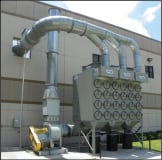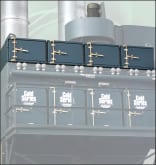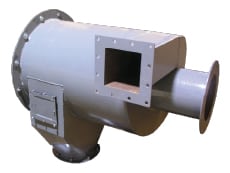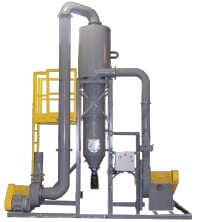The U.S. Occupational Safety and Health Admin. (OSHA; Washington, D.C.; www.osha.gov) has flagged combustible dusts as one of its top issues since the Imperial Sugar Mill explosion in Port Wentworth, Georgia, that killed 14 employees and injured many others in February 2008. Combustible dust is, in fact, one of OSHA’s National Emphasis Programs (NEPs).
The situation today
Despite the attention, however, OSHA does not yet actually have its own standard pertaining to combustible dust (see sidebar, Combustible Dust 101). Instead, the agency cites combustible dust hazards — including fire deflagration, explosion and related hazards — under its General Duty Clause (5(a)(1)). General Duty Clause citations related to combustible dust may be issued for deflagration, explosion or other fire hazards that may be caused by combustible dust within a dust collection system or other containers, such as bins or mixers. Compliance officers may rely upon National Fire Protection Agency (NFPA; Quincy, Mass.; www.nfpa.org) standards for evidence of recognition of the hazard, as well as consult relevant NFPA standards for evidence of feasible means of abatement. OSHA inspectors can also cite hazards not addressed in consensus standards under the General Duty Clause. This includes the statement that employers must furnish each employee with a place of employment that is free from recognized hazards that are causing, or are likely to cause, death or serious physical harm.

According to the Status Report on the Combustible Dust NEP, 11% of combustible-dust-related violations pertain to the General Duty Clause.
Citations can also be issued for deflagration, explosion or other fire hazards that may be caused by combustible dust within a dust collection system or other containers, such as mixers and bins. In addition, citations can be issued for conditions such as improper deflagration venting, ductwork-related problems, make-up air system and improper work practices.
What this means, in a nutshell, is that although there is currently no OSHA standard for combustible dusts, based upon a National Emphasis Program established by OSHA and Congress, OSHA can fine facilities that aren’t in compliance with relevant NFPA standards during routine inspections or inspections under the NEP, which generally occur in facilities that have accidents, fatalities or complaints related to combustible dust or in industries with a higher potential for combustible dust explosions and fires. (And, you can bet many chemical processors are in this category.)
Confused? You aren’t alone. Suppliers of dust collection equipment and systems say the uncertainty surrounding combustible dust compliance is the biggest challenge the chemical — or any other combustible-dust-producing — industry faces. “There really are no clear-cut guidelines,” says Jamie Scott, vice president of Air Handling Systems (Woodbridge, Conn.; www.airhand.com). “And this makes awareness and understanding the two biggest obstacles to compliance when it comes to combustible dust. It’s a double-edged sword, because although some processors don’t know exactly how to be in compliance due to a lack of an OSHA standard, they still can be cited during random or NEP inspections without even realizing they’re doing anything wrong.”
In an effort to avoid these citations, many chemical processors now are beginning to upgrade their dust collection equipment, but that also presents challenges. “There are so many different aspects of a system in terms of capturing, conveying and collecting the material in a safe and effective way. These steps include proper hood design, duct layouts, equipment selection, blower sizing, safety considerations for the workers and the combustible dust or explosion hazards of the collected material,” says Travis Haynam, director of business development and technical sales with United Air Specialists, Inc. (Cincinnati, Ohio; www.uasinc.com). “Every one of these aspects is critical and if one is not done correctly, the system may not meet the performance requirements or customer expectations.”
Compounding that problem is the issue that dust collection is what is considered by many to be a non-value- added expenditure. “Everyone knows they need to make their process safer and that knowledge is pushing processors to upgrade their dust collection equipment, but if they are barely making a profit at the moment, they don’t want to spend money on something that is not going to make them money,” says Matt Caulfield, Canadian sales director and Northeast regional manager with Camfil APC (Jonesboro, Ark.; www.farrapc.com). “But they must [invest in upgrades] because they also don’t want to get shut down…or worse.”
Taking action
The first step in overcoming the confusion — and getting the right equipment with the lowest possible capital outlay — is to analyze the dust and determine potential hazards, as well as what is required to achieve compliance with applicable regulations. Determining what the contaminant is and what regulations and permissible exposure limits or safety hazards are associated with that dust is crucial, notes United Air Specialists Haynam.
During this stage, it is critical to know what you’re dealing with, including the Kst value of the material, which will determine if there is a combustible dust issue. Kst is the dust deflagration index, and it measures the relative explosion severity compared to other dusts. Any material with a Kst value greater than zero is considered to be at risk of an explosion. Other than silicon or sand, every kind of dust is potentially combustible to some degree.
Most dust collection companies offer testing via an outside laboratory. If the laboratory finds that the dust is explosive, it will test the dust to determine the K st value and then issue a report stating the exact value. If it is not combustible, the report will state this. Documentation is important during an OSHA inspection to show that appropriate steps are being taken for the type of dust existing in the facility. “If there are several different Kst values present in a facility’s dust, we suggest taking the worst case scenario for the dust with the highest Kst value and, based on what NFPA requires, size the system for that Kst value,” says Camfils Caulfield.
Once the type and combustibility of the dust are identified, processors must ascertain which regulations apply and which permissible exposure limits or safety hazards are associated with that dust. The next step, according to Haynam, is to review the source of the dust and identify the best way to capture and contain it. From there, airflow requirements, ducting design and equipment type can be discussed. Keep in mind that different dusts require different solutions when selecting and configuring equipment. And, of course, combustible dusts require adequate means of protection, such as explosion venting or suppression systems.
“Unfortunately there’s not a one-size-fits-all solution. Each material, each process and each facility has different dust-collection and dust-safety needs and requirements,” explains Caulfield.
Other issues to keep in mind
However, experts warn that even a properly selected, sized and installed dust-collection system is not enough. Other steps are needed to achieve complete compliance, and to protect employees and assets.
 |
Housekeeping is the first line of defense in fighting the dust battle, no matter the type of dust. “Fugitive dust is often a problem because it collects on hung or dropped ceilings, flat ducting and flat hanging lights,” says Scott. “Anywhere that dust can accumulate out of sight is a problem because if there is a fire or explosion in a facility, the initial explosion shakes the building, which releases the dust sitting on these surfaces and, as the flames from the initial fire tear through the facility, this released fuel (the fugitive, dispersed dust) can be ignited, creating additional explosions. For this reason, it is imperative to collect dust at its source and keep up with housekeeping to prevent it from accumulating on these surfaces.”
While dust collection equipment is often viewed as a necessary evil, Daniel Novicky, sales engineer at Aerodyne Environmental, Inc. (Chagrin Falls, Ohio; www.dustcollectorhq.com), says there are ways to minimize the expense associated with it. “Look for equipment that limits downtime, reduces the frequency of maintenance and the cost of working on that equipment, as well as well-made equipment that does not need frequent replacement.”
Worker training is also very important. “OSHA interviews your employees,” says Scott. “They want to know if the workers are aware of, trained about and know how to handle issues. So training your employees on hazardous dust handling goes a long way toward avoiding OSHA citations and loss related to explosions.”

